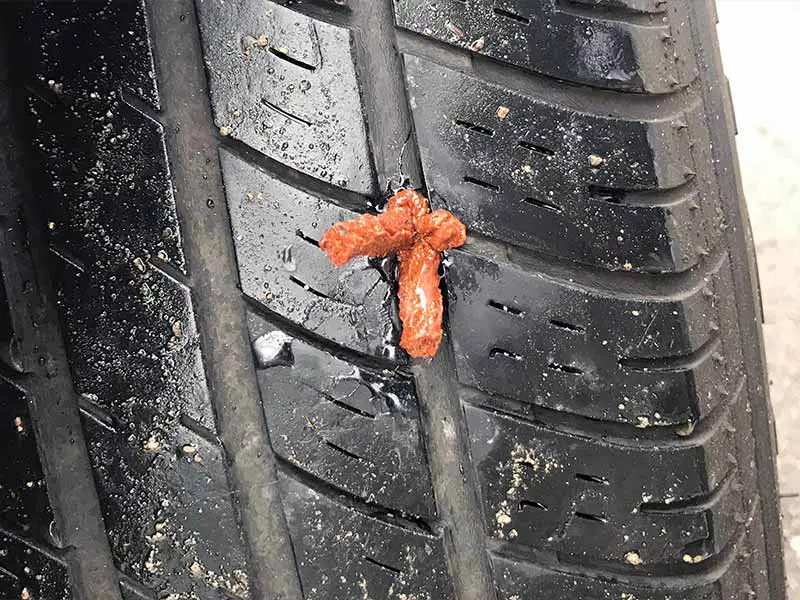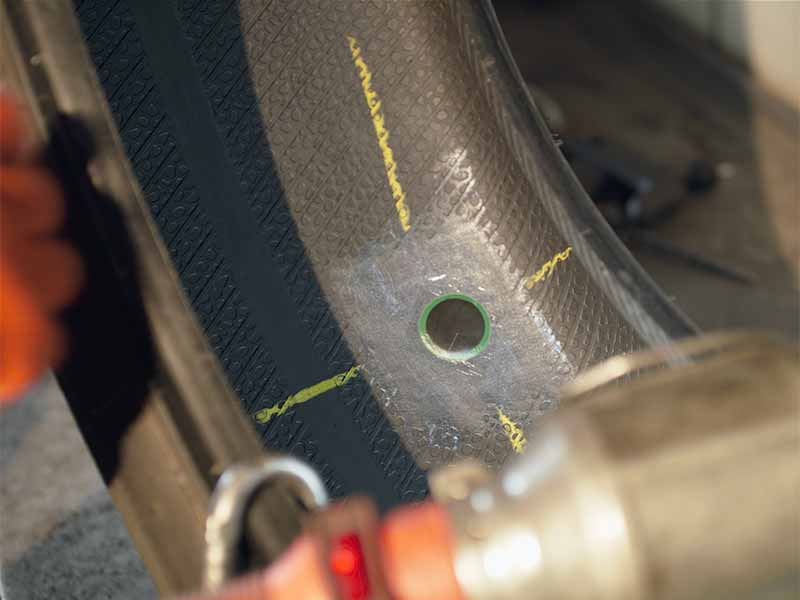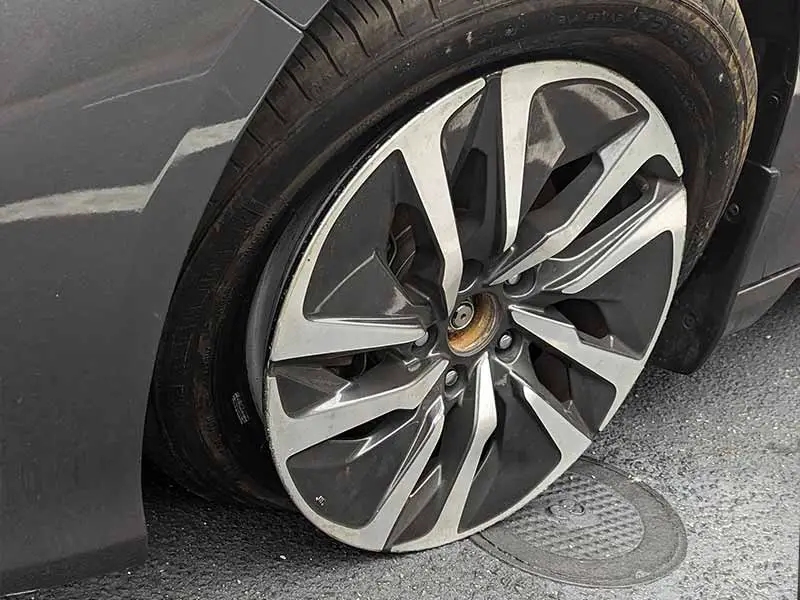When it comes to driving on patched tires, it’s important to understand the safe speed limit to avoid accidents or further damage to your tires. It’s also important to understand what speeds different types of tire repairs can handle.
How Fast Can You Drive On A Patched Tire?
You can drive safely on a professionally patched tire up to and beyond the posted speed limit. However, you should avoid approaching the limits of the tire’s speed rating, where a tire will reach its thermal maximum.
Tires with plugs or sealants should be treated the same as spare tires and limited to 50 miles per hour.
Since there’s some confusion around the differences between plugging, patching, and using sealant to fix a flat tire, we’ll cover all the bases.
Let’s take a closer look.
Difference Between Plugs, Patches, And Sealants
Tire plugs, tire patches, and tire sealants are all used to fix a flat tire or tire puncture. However, they are not all created equal.
Tire Plugs
A tire plug is a small piece of rubber inserted into the punctured area of the tire. Tire plugs are typically used for small punctures no larger than 1/4″ and can be a quick and easy roadside fix. However, they are not meant to be a permanent solution and should only be temporary. They are often strengthened with an adhesive.

Tire Patches
A tire patch is a larger piece of rubber applied to the inside of the tire, covering the punctured area and bonding to the inner liner of the tire with a vulcanizing cement after using a buffing tool to prepare the area properly. Tire patches are a permanent fix and can be used to repair larger punctures up to 1/2″. However, they can take longer to apply and require the tire to be removed from the wheel.

Tire Sealants
Tire sealants are liquids injected into the tire through the valve stem. The sealant then covers the inside of the tire and seals any punctures. Like tire plugs, tire sealants are intended as a temporary fix and should not be used as a replacement for a proper tire repair patch.
When it comes to the effectiveness of these three options, tire patches are considered the most effective and long-lasting solution, while tire plugs and sealants are best used as a temporary fix until you can get to a tire shop.

How Fast Can You Drive On A Professionally Patched Tire?
A professionally patched tire is essentially as good as the same tire with the same amount of tread wear that hasn’t been punctured. Tire professionals will only fix a tire that has been punctured in the tread area and far enough away from the sidewall to prevent a patched tire from failing due to too much flexing.
You need to also consider the speed rating of the tire itself. For instance, a tire with a speed rating of “H” should not exceed 130 MPH. This doesn’t mean any tire appropriately repaired can be driven at any arbitrary high speed.
Tire rubber and the tire’s structure have to deal with incredible amounts of heat at the top of their speed ratings. These speeds are hard on a tire without the added issue of punctured tire rubber.
Personally, I wouldn’t recommend significantly exceeding the posted speed limits with any tire that is damaged. Properly patching tires will allow them to work as well as the original tire for everyday road use, but you shouldn’t push them to the extremes.
| SPEED SYMBOL | MAX SAFE MPH |
|---|---|
| A1 | 3 |
| A2 | 6 |
| A3 | 9 |
| A4 | 12 |
| A5 | 16 |
| A6 | 19 |
| A7 | 22 |
| A8 | 25 |
| B | 31 |
| C | 37 |
| D | 40 |
| E | 43 |
| F | 50 |
| G | 56 |
| J | 62 |
| SPEED SYMBOL | MAX SAFE MPH |
|---|---|
| K | 68 |
| L | 75 |
| M | 81 |
| N | 87 |
| P | 93 |
| Q | 99 |
| R | 106 |
| S | 112 |
| T | 118 |
| U | 124 |
| H | 130 |
| V | 149 |
| W [Within ZR] | 168 |
| Y [Within ZR] | 186 |
| (Y) [Within ZR] | Above 186 |
ZR includes all tires with a rating above 149mph
How Fast Can You Drive On A Plugged Tire?
The safe speed limit for driving on a plugged tire is typically around 50 mph. Driving at higher speeds on a plugged tire can put additional stress on the tire and could potentially cause the plug to come out and go flat.
Depending on the severity of the damage, driving at higher speeds could cause the tire not just to go flat again but blow out and cause you to lose control.
Not all tire plugs are created equal. Some tire plug kits come with adhesive, while others do not and simply rely on friction to hold the plug in the hole. Even the best plug kits are less effective than a professionally patched tire.

How Fast Can You Drive With Fix A Flat Tire Sealant?
The safe speed limit for driving on a tire treated with fix-a-flat sealant is also typically around 50 mph. Fix-A-Flat type sealants may void the tire’s warranty and should be used only as a temporary fix.
Tire sealants are the weakest of the methods used to repair a tire and are the most likely to fail. They are only effective for patching very small punctures. The larger the hole, the less likely the sealant will hold up to higher speeds or for longer periods.
How Long Do Tire Patches Last?
A professionally patched tire should last for the remaining life of the tire. So you can drive on it as long as your tire will last. A tire professional will only repair a tire if the puncture is in an area that won’t experience severe flexing and stretching and isn’t too close to any other repairs.
A new tire’s lifespan can be 7 to 10 years, and a properly installed tire patch can last this long, even on a new tire, when properly maintained.
How Long Do Tire Plugs Last?
The lifespan of a tire plug can vary depending on the puncture’s size and location. On average, a properly installed plug can last for several months or even longer. However, tire plugs are not intended as long-term fixes and should be replaced with a proper tire patch as soon as possible.
Tire plugs also are not capable of sealing larger holes. Punctures larger than 1/4″ are too large for a plug to keep from leaking. Larger punctures can still be repaired but require a patch to seal the leak.
How Long Do Tire Sealants Last?
A tire sealant like Fix-A-Flat can last for several weeks, but it is not recommended to attempt to drive on a tire that only uses a sealant to hold air for an extended period.
Sealants should be used in the same way that you would use a spare tire. Spare tires should only be driven on for 50 miles and not used for speeds above 50 MPH.
Some tire shops will refuse to patch a tire that has a sealant used. This is due to the labor required to clean it out, which can quickly make it smarter for the consumer to put that expense toward a replacement tire. Removing sealants from tires shortly after they’ve been injected into the tire is easier.
It’s also important to note that some sealants can harm metal alloys and cause damage to the wheel or rim that your tire is mounted onto when left for extended periods.
Tire Safety & Maintenance Tips
Regular tire maintenance is important for ensuring your tires’ safety and long life. This includes regular tire pressure checks and rotation. Properly inflated tires can improve fuel efficiency, increase the lifespan of your tires, and improve your vehicle’s handling. Tire rotation ensures that all tires wear evenly, which can help to prolong their lifespan.
Act quickly to have tires with plugs or sealants repaired or replaced after a flat tire emergency. Flat tires with plugs or patches are temporary fixes. You should only drive up to 50 MPH with a plug or sealant and on for 50 miles.
A tire patch that has been properly applied is safe to drive at the recommended speed limit or a bit above. Although pushing the limits of the tire manufacturer’s speed rating is not recommended.
If you happen to be considering using a patched tire for a track day or hitting the Autobahn, I recommend buying new tires instead.
Resources
Below are some links you may find helpful when learning about tires
- Plugging a tire vs patching a tire: Which repair is better? – AutoZone
- How to use a flat tire sealant kit – Haynes
Final Thoughts
Understanding the safe speed limit for driving on a patched tire is crucial for maintaining the safety of yourself and others on the road. A patched tire is a tire that has been repaired using a patch, plug, or sealant.
The most common method of patching a tire is by using a patch, which is a piece of rubber that is inserted into the punctured area of the tire. Another way is by using a plug, a small piece of rubber inserted into the punctured area and then expanded to seal the hole. The third method uses a sealant, a liquid sprayed into the tire through the valve stem, which seals the punctured area.
The speed limit for a plugged tire is typically around 50 mph, but this can vary depending on the size of the puncture and the location of the hole on the tire.
Tire maintenance, including regular tire pressure checks and rotation, regular tire inspection, and replacing tires when needed, are all crucial for maintaining the safety and longevity of your tires.
Good luck and happy motoring.




